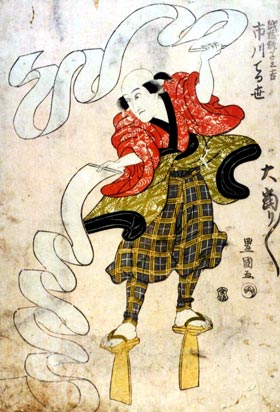| ECHIGO JISHI |
| Dance title | Echigo Jishi Osozakura Teniha no Nana Moji |
| Authors | Nagawa Tokusuke I, Matsui Kôzô I, Shinoda Kinji I (lyrics) Kineya Rokuzaemon IX (music) |
| History |
The actor Nakamura Utaemon III performed in the 3rd lunar month of 1811 at the Nakamuraza a 7-role hengemono, which was entitled "Osozakura Teniha no Nana Moji". The 4th of these roles, the Echigo Jishi, survived and became the independent dance "Echigo Jishi". |
| Key words |
Echigo
Ipponba Geta Kakubę Nagauta Nuno-zarashi Shakkyômono Shishi Shosagoto |
| Summary |
The idea for the piece is taken from a traditional folk performing art called Echigo Jishi (also known as Kakubę Jishi since it was created by a man called Kakubę from Kanbara in the Echigo province, present Niigata Prefecture). In this dance a man wearing a carved lion-head, which is considerably stylized and gorgeously lacquered in vermilion and gold, does an acrobatic, comical, ceremonial dance as an auspicious lion. The tegoto (instrumental interlude) section in two parts depicts the lion dance itself. One structural feature of the text is an enumeration of the noted products of the Echigo region, such as eels, hemp rope, cambric, cotton crepe and herbs, as well as, of course, the lion dance. On the surface, this presentation does not follow a single line of logic. But on another level, the seemingly unrelated words have amorous associations which reveal a sub-stream of playful love flowing through the piece. Consequently, the text contains complicated puns and subtle allusions, which are virtually untranslatable. Source: Tsuge Gen'ichi (more details) |
 |
|
Ichikawa Teruyo I performing the dance "Echigo Jishi" in the 6th lunar month of 1811 at the Yűkiza (print made by Utagawa Toyokuni I) |
|
|
| Contact | Main | Top | Updates | Actors | Plays | Playwrights | Programs | Links | FAQ | Glossary | Chronology | Illustrations | Prints | Characters | Derivatives | Theaters | Coming soon | News |